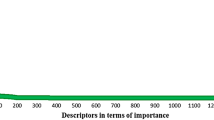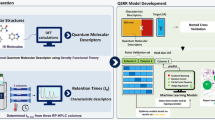Abstract
In this study, a quantitative structure–property relationship (QSPR) was proposed using the random forests (RF) and artificial neural network (ANN) for determining the retention time (RT) of 123 polycyclic aromatic hydrocarbons (PAHs) in tire fire products. The data containing the RT of the PAHs were obtained by gas chromatography–mass spectrometry (GC–MS) method. The optimum number of trees (nt) and the number of randomly selected variables to split each node (m) related to the RF model were found 100 and 101, respectively. Different algorithms of ANN were studied, and Levenberg–Marquardt (LM) algorithm with a minimum mean square error (MSE) was selected as the best algorithm. Also, leave-one-out cross-validation (LOOCV), including correlation determination (R2), standard error of prediction (SEP), mean absolute error (MAE), relative error prediction (REP), mean squared error (MSE), mean relative error (MRE), and predicted residual sum of squares (PRESS), was applied to investigate the validity of statistical models. The R2 of the RF, stepwise regression artificial neural network (SR-ANN), and RF-ANN models were achieved 0.985, 0.983, and 0.959, respectively. An effective model, which does not require experimental steps, was proposed for the RT prediction of new compounds.








Similar content being viewed by others
References
Mojiri A, Zhou JL, Ohashi A, Ozaki N, Kindaichi T (2019). Sci Total Environ 696:133971
El Husseini M, Makkouk R, Rabaa A, Al Omar F, Jaber F (2018). Food Anal Methods 11:201–214
Abdalla Mahgoub H (2013) Int. J Sci Res 5:268–272
Kabzinski AKM, Cyran J, Juszczak R (2002). Pol J Environ Stud 11:695–706
Wang X, Xu Q, Hu X, Han F, Zhu C (2020). Spectrochim Acta A Mol Biomol Spectrosc 228:117783
Hu B, Gao Z, Wang H, Wang J, Cheng M (2020). Comput Mater Sci 179:109677
Adekunle AS, Oyedele Oyekunle JA, Samson Ojo O, Maxakato NW, Olutonac GO, Ruth Obisesana O (2017). Toxicol Rep 4:39–48
Corrotea Y, Sanchez K, Angelica Rubio M, Richter P (2014). J Chil Chem Soc 59:2477–2480
Shamsipur M, Hashemi B (2015). RSC Adv 5:20339–20345
Zitka O, Babula P, Sochor J et al (2012). Int J Electrochem Sci 7:908–927
Candice Lung Sh C, Hu Liu C (2015). Sci Rep 5:12992
Martín Santos P, del Nogal SM, Luis Pérez Pavón J, Moreno Cordero B, Verde Fernández R (2019). Talanta 192:69–78
Matin AA, Biparva P, Gheshlaghi M (2014). J Chromatogr A 1374:50–57
Henrique Petrarca M, Teixeira GH (2018). Food Chem 257:44–52
Zhou W, Zhang H, Deng C, Chen Y, Liao J, Chen Zh XJ (2019). J Chromatogr A 1604:460473
Haji Hosseini M, Rezaee M, Akbarian S, Mizani F, Pourjavid MR, Arabieh M (2013). Anal Chim Acta 762:54–60
Sarrafi AHM, Feizbakhsh A, Dashtbozorgi Z (2013). J Chem 2013:1–13
Veenaas C, Linusson A, Haglund P (2018). Anal Bioanal Chem 410:7931–7941
Miller TH, Musenga A, Cowan DA, Barron LP (2013). Anal Chem 85:10330–10337
Noorizadeh H, Farmany A (2014). Food Anal Methods 7:580–590
Sarkhosh M, Ghasemi JB, Ayati M (2012). Chem Cent J 6:S4
Goodarzi M, Chen T, Freitas MP (2010). Chemom Intell Lab Syst 104:260–264
Goudarzi N, Shahsavani D, Emadi-Gandaghi F, Arab Chamjangalia M (2014). J Chromatogr A 1333:25–31
Izquierdo-Verdiguier E, Zurita-Milla R (2020). Int J Appl Earth Obs Geoinf 88:102051
Zhou X, Lu P, Zheng Z, Tolliver D, Keramati A (2020). Reliab Eng Syst Saf 200:106931
Gupta MK, Gupta S, Rawal RK (2016) Impact of Artificial Neural Networks in QSAR and Computational Modeling, Artificial Neural Network for Drug Design, Delivery and Disposition. Chapter 8, pp. 153–179
Wang Z, Li K, Lambert P, Yang C (2007). J Chromatogr A 1139:14–26
Mauri A, Consonni V, Todeschini R (2015) Molecular Descriptors, Handbook of Computational Chemistry. Springer Science+Business Media Dordrecht. pp 1–29
Author information
Authors and Affiliations
Corresponding author
Ethics declarations
Conflict of interest
The authors declare that they have no conflict of interest.
Additional information
Publisher’s note
Springer Nature remains neutral with regard to jurisdictional claims in published maps and institutional affiliations.
Rights and permissions
About this article
Cite this article
Emrarian, M., Sohrabi, M.R., Goudarzi, N. et al. Retention time prediction of polycyclic aromatic hydrocarbons in gas chromatography–mass spectrometry using QSPR based on random forests and artificial neural network. Struct Chem 32, 49–61 (2021). https://doi.org/10.1007/s11224-020-01614-9
Received:
Accepted:
Published:
Issue Date:
DOI: https://doi.org/10.1007/s11224-020-01614-9




